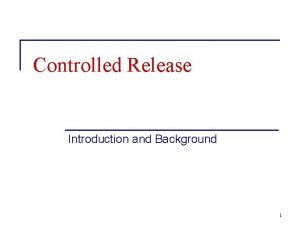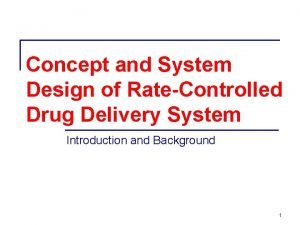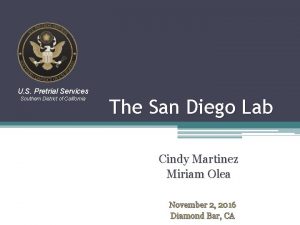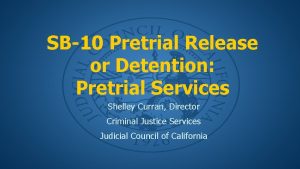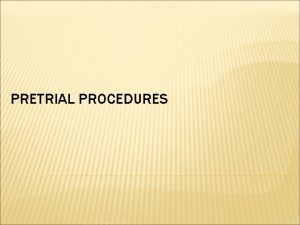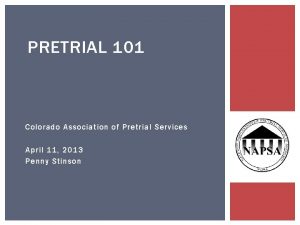PreTrial and Trial Procedure PreTrial Release Show Cause










- Slides: 10

Pre-Trial and Trial Procedure

Pre-Trial Release Show Cause Hearing (aka bail hearing): • Crown has to prove why accused should be held until trial • For less serious offences, release before trial is usually automatic • Accused sign a promise to appear agreement • Accused may have to sign a recognizance: – A guarantee that they will appear (will be fined if they don’t show up)

Pre-Trial Release • Police may request a surety: – A person who agrees to pay if the accused doesn’t show up • Accused must sign an undertaking: – A document outlining conditions that the accused must follow, such as a curfew, or orders not to associate with certain people or visit certain places.

Bail • For serious offences, police will want to keep the accused in custody until trial • Accused can make a bail application • A show-cause hearing is held to give the Crown the opportunity to convince the judge the person should remain behind bars – Ex. accused may flee, safety concern to others

Bail • Reverse onus: The defence must show that the accused’s release on bail is justified. • Occurs if: 1. The accused is charged with serious offence while already out on bail, or 2. The accused is not a Canadian resident, or 3. The charge is breach of bail condition 4. The accused is charged with importing, trafficking, or possession for the purpose of trafficking narcotics

Non-Trial Route (aka Plea Bargain/Plea Negotiation) • Plea Bargaining: • When the accused pleads guilty to a lesser charge so that the more serious charge is dropped • Benefits to the Accused: • Reduced sentence (this is the main reason in most cases) • Reduced publicity; no high profile trial; “get on with life” • Saves time and money

Non-Trial Route (aka Plea Bargain/Plea Negotiation) • Benefits to the Crown and Society: • Saves times and money; reduces number of cases going to trial • Guaranteed conviction • Plea bargain may also include an agreement that the accused provide information or testify in another case • Can save the victims or their families a great deal of stress if they do not have to testify in a trial • NOTE – Less than 10% of cases make it to trial. The other 90% are plea negotiated.

Trial Route The Preliminary Hearing: • Enables provincial judge to decide whethere is sufficient evidence to proceed with a trial in a higher court. • IF there is not, accused will be discharged, and charges will be dropped. • At the preliminary hearing the Crown presents some evidence (enough to convince judge that a reasonable jury could find the accused guilty on the evidence available) • NOTE – not necessary at this stage to prove that the accused is guilty beyond a reasonable doubt (police must continue to collect evidence throughout process)

Trial Route The Preliminary Hearing: • Disclosure of Evidence: • Prior to a trial, the Crown must disclose all of its evidence to the Defence so that the accused fully understands the Crown’s case and so that a defence can be prepared. • The Defence may disclose evidence or arguments that prove to the Crown that it (the Crown) does not have a case.

Trial Route The Preliminary Hearing: • Time Served: • Time served in jail (custody) before found guilty – counts as time and a half as an “innocent” person waiting for trial • For example – 9 years sentence – if you serve 2 year waiting for trial, technically you have served 3 years (time and a half per year) • Note – justice system is now trying to change this for 1 day (not changed yet)
 Difference between sustained release and controlled release
Difference between sustained release and controlled release Extended release vs sustained release
Extended release vs sustained release Extended release vs sustained release
Extended release vs sustained release San diego pretrial services
San diego pretrial services Ediscovery bexar county
Ediscovery bexar county What's a subtopic
What's a subtopic Underlying cause and immediate cause
Underlying cause and immediate cause Ultimate cause of behavior
Ultimate cause of behavior Proximate causation vs ultimate causation
Proximate causation vs ultimate causation Difference between innate and learned behavior
Difference between innate and learned behavior Pressure and release model
Pressure and release model

